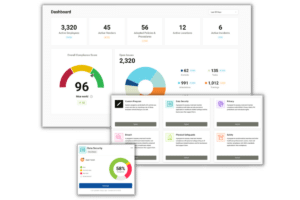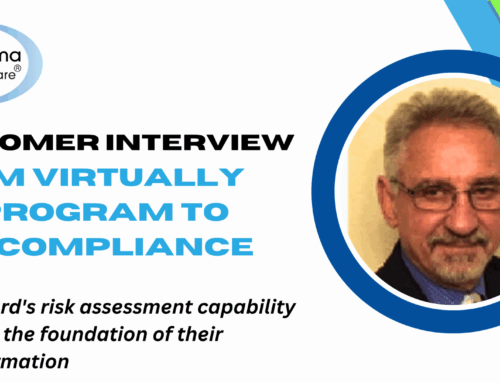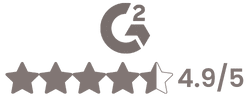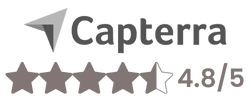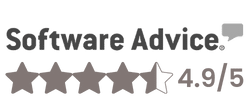
Healthcare compliance failures carry devastating consequences that extend far beyond financial penalties—they can erode patient trust, damage reputations, and disrupt operations. As enforcement actions intensify and cyber threats continue to escalate, compliance officers are under more pressure than ever to protect organizational integrity while navigating increasingly complex regulatory demands.
Yet despite these growing challenges, 60% of compliance officers are still relying on spreadsheets to manage their programs. While once considered best practice, manual methods like these are now outdated, inefficient, and prone to human error. In a rapidly evolving healthcare environment—where implementing a new EHR system or navigating a merger can introduce fresh compliance risks—relying on spreadsheets is not just ineffective, it’s risky.
Regular compliance audits are essential for identifying and addressing vulnerabilities. But if self-audits are mishandled or buried in cumbersome manual processes, they become time-consuming, incomplete, and ultimately ineffective.
The solution? Modern compliance audit software—a smarter, faster way to stay ahead of regulatory demands, reduce risk, and safeguard your organization’s future.
Why Spreadsheets Are No Longer Sufficient
Manual compliance processes create multiple points of failure that experienced Compliance Officers recognize as unacceptable risks:
- Human Error Amplification: Manual data entry and tracking increases the likelihood of oversights, missed deadlines, and incomplete documentation—errors that can trigger regulatory scrutiny and enforcement actions.
- Limited Scalability: As organizations grow, merge, or implement new technologies like EHR systems, spreadsheet-based tracking becomes increasingly unwieldy and error-prone.
- Inadequate Risk Assessment: Traditional manual methods lack sophisticated risk scoring capabilities, making it difficult to prioritize remediation efforts based on actual regulatory impact.
- Poor Audit Trail Documentation: Regulatory auditors increasingly demand comprehensive documentation of compliance efforts, something manual systems struggle to provide consistently.
- Third-Party Compliance Gaps: Organizations face significant challenges in managing third-party compliance risks, with many adopting reactive rather than proactive approaches to vendor risk management—a strategy that leaves organizations vulnerable to cascading compliance failures.
Advantage of Compliance Auditing Software
Modern compliance audit software functions as purpose-built project management for your compliance program. These platforms come equipped with preloaded templates aligned to regulatory requirements, along with advanced risk scoring and reporting tools.
Advanced Risk Assessment and Prioritization
Healthcare auditing companies have developed sophisticated risk scoring algorithms that help compliance officers identify and prioritize the most critical vulnerabilities. This data-driven approach enables strategic resource allocation, ensuring that high-risk areas receive immediate attention while lower-priority items are systematically addressed.
Regulatory Template Integration
Professional compliance audit software includes built-in templates aligned with current regulatory requirements, automatically updating as regulations evolve. This ensures that compliance officers are always working with the most current standards without the burden of manually tracking regulatory changes.
Automated Task Management and Accountability
When compliance gaps are identified, modern software systems automatically generate remediation tasks with clear accountability assignments. For example, if an audit reveals patient data protection deficiencies, the system will recommend specific corrective actions based on regulatory requirements, allowing tasks to be assigned to appropriate personnel and for compliance officers to track these efforts.
Market Validation and ROI Considerations
The healthcare compliance software market validates the critical need for automated solutions. The market was valued at $2.8 billion in 2022 and is projected to reach $6.5 billion by 2030, growing at a compound annual growth rate (CAGR) of 11.6%. This growth reflects the increasing recognition among healthcare organizations that manual compliance management is no longer viable.
For U.S. healthcare organizations specifically, the market is expected to reach $2.6 billion by 2030, driven by stringent regulatory requirements and the shift toward value-based care models that demand comprehensive compliance documentation.
Evaluating Compliance Auditing Software for Healthcare
You should evaluate compliance auditing software based on several critical factors:
- Regulatory Coverage: Ensure the platform covers all relevant regulations including HIPAA, HITECH, and emerging cybersecurity requirements.
- Integration Capabilities: The software should integrate seamlessly with existing systems, including HR platforms, to facilitate workforce compliance.
- Scalability: Choose solutions that can accommodate organizational growth and evolving compliance requirements.
- Audit Trail Functionality: Robust documentation capabilities are essential for regulatory audits and enforcement proceedings.
- Real-Time Monitoring: Advanced platforms provide continuous compliance monitoring rather than periodic snapshot assessments.
Moving Beyond Manual Processes
The compliance landscape is evolving rapidly and regulatory enforcement is intensifying. Healthcare organizations relying on manual processes are facing growing risks—regulatory penalties, data breaches, and costly disruptions.
That’s where The Guard™ comes in.
Compliancy Group’s healthcare compliance tracking software—The Guard™—gives Compliance Officers complete visibility into their organization’s compliance posture. With real-time audit execution, risk assessment, and automated remediation workflows, The Guard transforms how compliance is managed across complex healthcare environments.
When an audit uncovers a gap—say, in how you’re protecting patient data—The Guard doesn’t just highlight the issue. It provides actionable, regulation-aligned recommendations and automatically creates a task. That task can be assigned to the appropriate team member (like IT), and all tracking happens within the platform for full accountability.
Manual processes can no longer keep up. The cost of sticking with spreadsheets and siloed checklists—through inefficiencies, increased regulatory risk, and wasted resources—now far outweighs the investment in modern compliance software.
